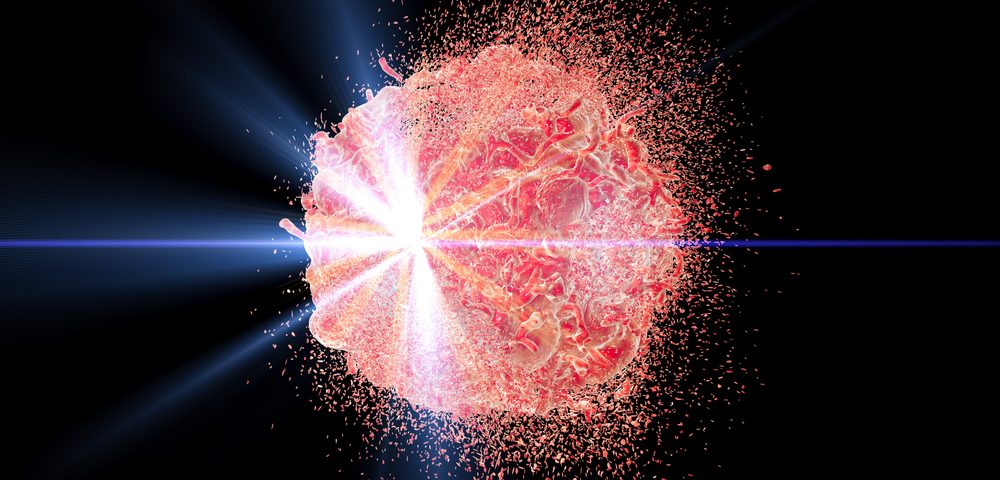Nanospectra Biosciences‘ AuroLase Therapy, a focal therapy for prostate cancer that uses gold-silica nanoparticles, showed a good safety profile and evidence of successfully eliminating the cancer in a pilot clinical trial.
Results were published in the journal PNAS, in the study, “Gold nanoshell-localized photothermal ablation of prostate tumors in a clinical pilot device study.”
Prostate cancer can be treated by removing the entire prostate, but this causes its own side effects. A focus is on therapies that can more specifically kill cancer cells, but leave healthy prostate tissue intact.
AuroLase aims to do this using nanoparticles called AuroShells — small spheres of silica glass wrapped in a thin layer of gold – and lasers. The gold nanoparticles are small enough to cross the tumor’s leaky vasculature, but not vessels in healthy tissue, which makes them specific to tumor sites.
Once AuroShells accumulate in the tumor, clinicians can hit these cancerous areas with a laser (a beam of near-infared light), which is harmless and passes through body tissue without having any effect. But when it hits the nanoparticles, they heat up, effectively burning away the cancer inside the body.
Because the laser can be directed precisely, this technique is not expected to damage healthy prostate tissue or other nearby structures, which could be injured by a more radical treatment such as surgery.
An ongoing feasibility clinical trial (NCT02680535), sponsored by Nanospectra, is examining the safety and efficacy of AuroLase in up to 45 localized prostate cancer patients with a low to intermediate risk of progression.
Patients must have their cancer regions visible through MRI/US fusion imaging — a technique that combines magnetic resonance imaging and ultrasound — which will be used to guide the laser irradiation 12 to 36 hours after AuroShells are injected.
The treatment’s efficacy and the extent of tumor ablation will be examined with MRI scans two to three days after the procedure, and patients and will undergo MRI/US fusion guided biopsies at three and 12 months. The study’s primary measure of effectiveness is the proportion of patients having negative biopsies at three months with minimal damage to surrounding healthy tissue.
Researchers reported data from the first 16 patients included in the trial, 15 of whom completed treatment with AuroLase.
One participant stopped treatment due pain in the lower chest, which was thought to be a side effect of the infused AuroShells being taken directly from cold storage. In subsequent infusions, the nanoparticles were warmed to body temperature before use, and no other patients experienced this side effect.
There were no serious adverse events in the study. Five patients required the use of catheters. One of those experienced some penile bleeding during erections after the procedure, which was attributed to the catheter, not the therapy itself.
Imaging scans taken 48 to 72 hours after the procedure showed that all 15 patients who completed treatment with AuroLase had a successful prostate cancer ablation.
Three months after the treatment, biopsies were taken for 16 cancer lesions in the 15 treated patients (in one patient two lesions were sampled). All had evidence of dead tissue, and 62.5% had negative biopsies. After one year, the number raised to 87.5%.
While some researchers believe that “undersampling of the targeted region” might be the reason why some positive biopsies at three months came back negative after one year, others think it’s more likely that AuroLase treatment induced an inflammatory response that continued the process of killing tumor cells months after the treatment itself.
However, more studies will be needed to be certain.
It should be stressed that this preliminary study was not powered for efficacy — that is, for statistical reasons, it’s impossible to make reliable conclusions about the effectiveness of the treatment. “Thus,” the researchers cautioned in their paper, “any interpretation of efficacy remains premature.” New trials designed to evaluate efficacy are expected to begin in the coming months.
“This first in human pilot device study demonstrates that [AuroShells]-directed laser excitation and ablation is a safe and technically feasible procedure for the targeted thermal destruction of prostate tumors and I am very excited to be part of this new frontier in nanomedicine,” Ardeshir R. Rastinehad, DO, a professor at the Icahn School of Medicine at Mount Sinai in New York, and a study co-author, said in a press release.
Added David Jorden, CEO of Nanospectra: “We are encouraged by the clinical success of our feasibility study to date and look forward to the initiation, potentially next month, of the pivotal study with an expected cumulative treatment population of 100 subjects.”
The pivotal study, approved to open by the U.S. Food and Drug Administration, is expected to include an additional 60 patients with low to intermediate prostate cancer at up to eight sites in the U.S.
The company is also in early discussions to initiate clinical studies of AuroLase in Europe, with the U.K. “likely as the first country with an active clinical presence,” Jorden told Prostate Cancer News Today.

